Stone, minerals and semiprecious of the world stone
Silicate: Disthene, kyanite, cyanite -->rus
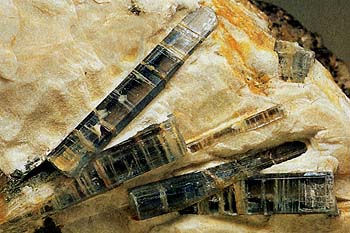 Diagnostic cart.
Diagnostic cart.
On a photo. Prismatic crystals of cyanite from the famous deposit of Picco-Forno (Canton of Tichino, Switzerland).
Al2 O SiO4
Crystal structure triclinic
Hardness on the Mohs scale 4-7,5 (depending on direction)
Specific unit weight mass 3,53-3,67
Cleavage perfect absolute
Fracture, break wrong
Colors colourless, polycoloured (multicoloured)
Colors in powder triturate white
Glance (glitter, glare) from glass to mother-of-pearl

Forms prismatic crystals, extended or flatten, as a rule, not having completion. Cleavage perfect absolute along a long verge. Crystals often unite in subparallel bunches, painted in an intensive enough blue color (at a center, colouring is thicker). Rarer this mineral has the white, grey or greenish colouring, distributed spots. Transparent, brilliance from glass to mother-of-pearl on the planes of cleavage. Formula: Al2 O SiO4 is complex chemical form of the corundum (Al2 O3) with quartz (type of millstone flint SiO2 or SiO2*H2O).
A cyanite (the "Kashmir sapphire" or as slang the "filibuster, flint", "corsair, pirate", "contrabandist, smuggler" and other), or Disthene, is widespread in nature, it behaves to the rockforming minerals. However much the transparent beautifully painted standards, suitable for cutting, meet rarely. A cyanite is crystallized in triclinic Crystal structure, pinacoidal class of symmetry. Form of his crystals usually long-columnar, basaltiform, plank-buttress tabular stone. Gravel fusiform crystals on Ural are named oatmeals. Often there are twins with a twin, twinning plane and joint, junction of radially going away crystals.
Chemical composition (chemistry, compound). Oxide of aluminium (Al2O3) 63,1%, silex (SiO2) 36,9%; as admixtures 1-2% is present Fе2О3, to 1,8% Si2O3, in the negligible quantities of CaO, MgO, FeO, TiO2. Hardness on the Mohs scale. 6 and transversal and 4,5 end-on extended-prismatic crystals; Fracture, break. Fibred. Form of crystalline excretions. Stolbchatye, made of board, crystals, fibred, radiant, fissile excretions. Class of symmetry. Pinacoidal - 1. Cleavage. Middle on a base (athwart axes with) (100), (010), (001). Aggregates. Radially-radiant, grainy.
Colors of cyanite of blue, dark blue, green, violet, pink, rose, marked and colourless. The blue colouring is bound to the incoming in the structure of cyanite admixtures of Cr, Fe2+ and Fe3+ or Ti, and green - Fe3+. Colouring in different crystallography directions changes from violet-blue to colourless and cobalt-dark blue or from chlor to green. Crystals are known with the effect of "cat's-eye". Glance (glitter, glare) glassy, on the planes of cleavage of mother-of-pear nacreous. Hardness on the Mohs scale sharply differs in different directions. This property was stipulated by the second name of cyanite - Disthene, di+stand, I.e. double stand (resistant, oppose) fragile frail brittle.
Diagnostic indication.
Hardness on the Mohs scale cyanite changes depending on direction in which to scratch slightly him. It is most hard athwart to lengthening and less hard parallell to him. A cyanite is refractory and does not dissolve in acids.
Origin provenance genesis.
A jewellery cyanite (as slang "Nabuchodonosor" or "Caliostro") behaves to the not very much widespread minerals. His origin is related to metamorphism (in the conditions of ever-higher pressures) of siltages, enriched an aluminium. Usually be found together with Staurolite, Granatite, Garnet and micas; very rarely has pegmatitic genesis. Very steady to weathering, therefore easily to meet him among loose fragmental deposits, appearing at destruction of Disthene rocks (sedimentary genesis). A cyanite be found in metamorphic rocks. Often extracted from mineral deposits. Beautiful blue-dark blue, sky-blue and violet cut cyanites were obtained on Ural (CIS).
Deposit minefield mine field occurrence subsoil.
For the whole world blue semilucent crystals are famous in an association with a paragonite (light mica) and Staurolite, Granatite, what be going on from Picco-forno in Canton of Tichino (Switzerland). Found out beautiful copies in Tyrol (Austria) and department of Morbian (France). The enormous crystals (to 30 sm in length) of the light-blue colouring, but opaque, are exposed in the state of Minas-zherays (Brazil). Green cyanites are opened in Machakos (Kenya).
In the industrial scales of deposit of cyanite developed in the USA (the states are Massachusetts, Connecticut and North Carolina), and also in India and Australia. The jeweller cyanites of India (states of Dzhammu and Kashmir, Pendzhab) are most known, from where they were brought as early as XVII century In Russia the Indian cyanites named of the bouse. The dark blue cut cyanites are alike on Sapphire, but hardness them much below, as well as indexes of refraction, and closeness. Blue and bluish (cyan) -зеленые cyanites are alike on Aquamarine, but characterized more high indexes of refraction and closeness. A jeweller cyanite is developed also in Burma, Brazil, Kenya, Switzerland and USA (in the states there is Montana, Nativeiya, Vermont, Connecticut, Massachusetts and other).
Use, practical application, deployment.
A cyanite is valuable mineral raw material for the production of insulants, steady at high temperatures and at influence of all of acids, including phosphorous. The cut cyanite is used on jeweller business. Cut the transparent stone of good value in a step or diamond form. With the effect of "cat's-eye" a shape is given the less transparent beautifully painted crystals or stone cabochons.
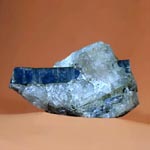
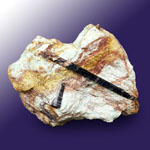
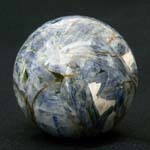
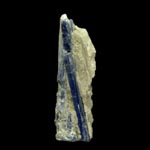
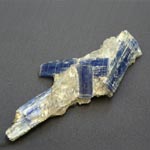
Distributing of colouring often lamellar, streaky, striate. Cutting a cyanite hardness from the anisotropy of hardness and perfect cleavage. Deposit minefield mine field occurrence subsoil is known in Burma, Brazil, Kenya, USA (state North Carolina), Austria (Tyrol), Switzerland (Sen-gotard). Entangling a cyanite is possible with aquamarine and Sapphire.
Disten, or a cyanite is a silicate of aluminium. Hardness on the Mohs scale along a crystal 4,5, across 7. Glance (glitter, glare) mother-of-pear nacreous to glass, transparent. Colors: blue, greenish, rarer light-grey; it is colourless. A line is white. Fracture, break rough. Cleavage perfect absolute. Crystals (triclinic Crystal structure) meet often. Places of distribution: Shpessart (Germany), Tyrol (Austria), Switzerland, India, USA, Brazil, CIS.
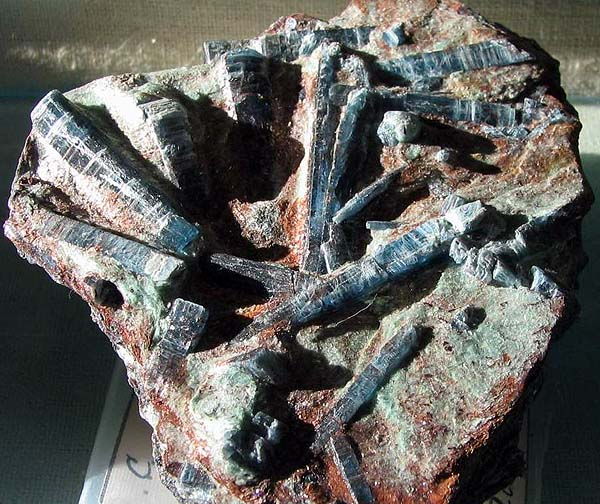
A cyanite is in mica slate. Borisovskie hills, to from Layer, Ural, Russia (CIS). A photo: © A.A. Evseev.
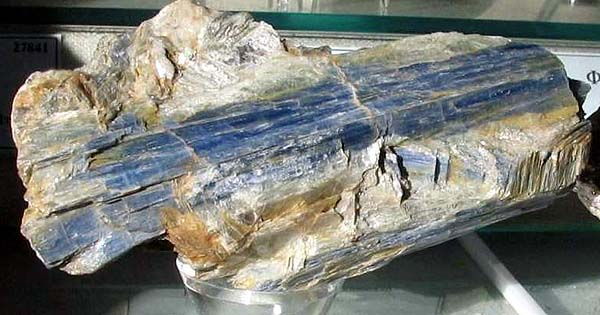
Cyanite. Yazgulem mountain ridge, Pamir, Tadjikistan (CIS). A photo: © A.A. Evseev.
